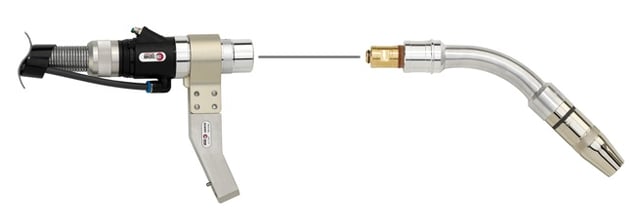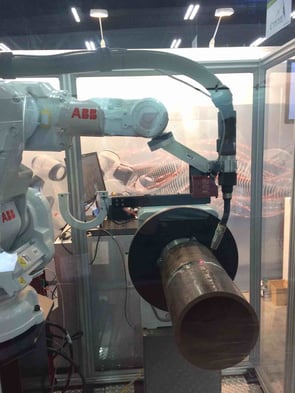So what does a robotic torch cost? You probably browse some of the welding equipment supplier websites and never see a price on those sites (ours included!), but then go to a welding distributor website or browse through their catalogs and get the List price from them. How do you know what you're paying for?
That's what this blog post is for. We're going to talk about the cost of a robotic torch - and what impacts the price you pay. There are a lot of factors that go into the total cost of a robotic torch, and that doesn't even include total cost of ownership, which will include not just the capital cost of the torch but also the cost of maintenance. It can also include training, maintenance on the torch, and peripherals. So, what are the main cost drivers of robotic torches?
Air-cooled or Water-cooled?
The biggest cost driver of any robotic torch is whether the torch is air-cooled or water-cooled in design and build. This usually has to do with your amperage, but not always. The heavier amperage you use for your robotic torch, the more the need for a water-cooled application is precipitated. A water-cooled torch is roughly twice as much as an air-cooled torch because of labor, material, and the machining involved. So how's that possible? Air-cooled torch designs are simplistic versus a water-cooled torch, and labor cost is the biggest factor as to why.
Starting at the swanneck, there's more layers and components that have to be silver-soldered together to allow for the water channels to flow to the front end of the torch. The block also has to be silver-soldered to allow for coolant to flow through the cable and into the front end. This is a process that is not normally automated because of the size of the pieces and precision involved. An air-cooled torch, conversely, is basically a solid block on the front end and back end. There's no machining of water channels, or extra hand-labor needed to solder small channels on to the swanneck. With air-cooled, it's solid copper or brass blocks and threaded or crimped connections.
Torch cable length can also be a big cost factor and drive cost up. Robotic torches in today's day and age roughly tend to be around the same length (3 to 5 feet). But, there are torches with remote mount feeders that can create cables 15, 20, or even 25 feet long. That amount of copper cable, materials etc. will drive up the price of your robotic torch compared to a 3 to 5 foot torch.
Over-arm vs. Through-arm
There's also over-arm vs. through-arm. The traditional over-arm style arm, while usually using a longer cable, is still more simplistic in it's design. The components are easier to install - an insulation flange, a mounting arm, and optional collision sensor is all that's needed to make up your torch package. This insulation flange is the usually the only critical component that is robot make and model specific on over-arm packages.
With through-arm, the torch package is strictly dependent on the robot and wire feeder make and model. Regardless of model, however, there are more usually more components that go into mounting a through-arm style robot, so the cost of robotic torch for a through-arm robot will typically be higher.

The robot model you use can also dictate the cost of the torch significantly. Collision sensing is a large cost driver on robotic torches, and that cost is saved if you use a robot OEM that has collision sensing built or programmed into the arm. OEMs like Fanuc, ABB (shown aside), and Kuka have collision sensing already included in their arc welding robots (as do others). Whether it's over-arm or through-arm - needing collision sensing in your torch package will be a significant cost driver.
Amperage and Torch Options
Amperage will be another factor in the cost of the robot torch. The higher the amperage the more copper will be needed in the cable to withstand the amperage load. So reasonably speaking, a 360-amp torch will cost less than a 500-amp torch. However, if you were to compare the cost of a 500-amp air-cooled torch and a 500-amp water-cooled torch, which are the industry standard, you would pay more (roughly 2x) for the water-cooled torch.
For torch options, the biggest cost driver you're going to encounter when paying for a robotic torch will be the wire brake. The wire brake is a fairly simple device that stops the electrode filler wire from moving when the robot arm is in motion. Using a wire brake will keep a consistent stick-out for touch sensing. This is another mechanized feature that's being added to the torch, so you're going to incur additional labor and part cost to install. In additional, the front module will always have to be modified to accommodate the wire brake installation.
Air Blast, Nozzle Sense, and Voltage Sense are other torch options that will increase the cost of the torch but don't require as much modification to the torch build to accommodate. Because of that they are not nearly as much a cost driver as Wire Brake. Air Blast, for instance, is simply adding an additional hose from the back end of the cable to the front end. Nozzle Sense and Voltage Sense would both require the additional of leads with a slight amount of soldering to install.
Foreign or Domestic?
The question of whether a domestically made or foreign made torch will cost more is another factor of cost that can be difficult to quantify. For instance, a torch of the same level in quality made in Canada against one made in Germany or made in the United States can come down to various factors like Exchange Rate and Import costs.
Sometimes the Exchange Rate can be in your favor, however, and a foreign-made torch from Germany could be less expensive as a result. If you were to import a robotic torch from far away such as China, you could end up paying less on labor and material but also get a torch of not-equal quality and having to pay more often to replace parts or the torch altogether.
Does Price Equal Value?
So does the price of the torch equal value? It's a question I personally struggle with. I would say price is a component of value, but it's not the only determining factor. Value has a lot of intangible qualities that are difficult to quantify. What's the relationship like between customer and vendor, or vendor and supplier? A strong relationship can increase that value significantly. If you're looking at the torch itself, you may look at more expensive options and say the price is more (and it is), but there can still be more value because of that options' expertise, build quality, and support.
Value is also a matter of perspective. The 500-amp air-cooled versus water-cooled torch is a great example of such perspective. While the cost of the water-cooled robotic torch will be more than the air-cooled every single time - and involve even more cost because you're going to need a water cooler and coolant to circulate through the torch, the total cost of ownership could easily be less than the air-cooled torch because you are certain to save on consumable cost over the life of the torch.
Now that you're more informed on what your torch may be costing you, why not see if your robotic torch is meeting your needs? We have an excellent eBook on robotic torches that goes into deep detail on torch making best practices and design-build. Check it out by clicking the button below:

